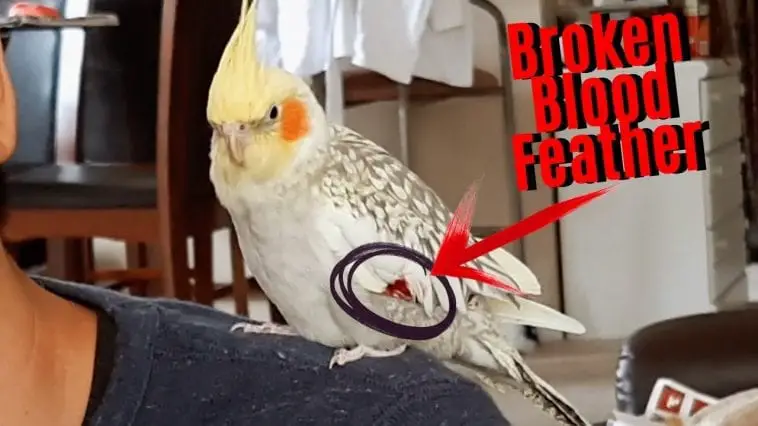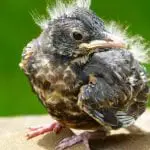If you are a bird lover and a bird owner, you must know about having blood feathers. All birds have it, so you must familiarize yourself with them and how you should behave in case, they get broken. Also known as pin feathers, these feathers can also encounter some problems, so you should prepare for it. Here are some important details to know about blood feathers and what you must do in case your feathered friend suddenly breaks it.
What Are Blood Feathers?
Blood feathers, also known as pin feathers, are feathers that are just beginning to show up and grow on the body of your birds. Because they are still completing their growth process, these feathers are still exposed to a large blood supply, and they can bleed when they break.
A single blood feather grows from a follicle, which is a special area in a person’s skin. The blood feather is also connected to arteries and veins that extend coming from the follicle. The blood serves as nourishment to help the feather to grow. Because of the color of the blood supply, a blood feather shaft’s color will appear dark, which is unlike the shaft of a matured feather, which will be colored white.
The blood feather has a larger calamus, also known as the quill, compared to a mature feather. It also starts out with having a waxy keratin sheath that serves as the feathers protection while it has not been fully completed. Eventually, when the bird’s feather has completely matured, the blood supply will begin to recede, and the bird will then fully reveal its waxy sheath.
Blood feathers will also appear during the process of the bird’s molting. Basically, this is due to the fact that old feathers will get lost, and new ones will appear as a replacement. This usually happens in the bird’s tail feathers and wing feathers. But the replacement does not happen suddenly but staggered, so there will be nothing that hinders the bird’s flying ability.
What Is A Broken Blood Feather Emergency?
A broken blood feather can be an emergency for a pet bird because broken blood feathers can behave similarly as an open faucet that will allow blood to pour out of your pet bird’s body. As birds cannot tolerate extreme blood loss, this process can become untreated in some cases.
First Things First: Always Be Prepared
Bird owners must know the necessary precautions about the needed knowledge of managing a broken blood feather. A bird’s first aid kit must be organized, and owners must make sure to include cotton balls, Styptic powder, and a hemostat inside it.
Owners must also have an organized hospital cage. By making sure that this is clean and ready, an owner will always be greatly prepared against accidents and emergency trips to the vet. When your bird is also having a routine check-up with their doctor, you should also ask for a demonstration on how to deal with a blood feather.
By being prepared for this type of emergency, you make everything easier for your bird while avoiding significant problems.
How To Treat A Broken Blood Feather
1. Stay Calm And Take A Deep Breath
Birds can be extremely sensitive in reading the emotions of people around them. This means that they take your behavior as cues on how they must react. Because of this, if they sense your fear, they will be choosing between a fight or flight response.
If you are acting like you are stressed out, this behavior will bring your bird to a downward spiral. This bird will panic, which will eventually increase the bird’s blood pressure and will lose a lot of blood.
This is why it is vital for you to remain calm at all times during the entire process. Act clinical and remain steady, just like you do not have an emotional attachment at all. If your bird feels that you are self-assured, it will match you with a confident behavior.
2. Answer the Question: Should You Induce Clotting?
The first thing that comes to mind when dealing with birds is to manage broken blood feathers with a clotting substance. The substance to stop clotting must be administered to the cracked feather shaft in order for the bleeding to be stopped. This can be done through the use of some common baking flour, styptic powder, and corn starch.
What you should do is to apply light pressure to the affected feather shaft so that the broken blood feather will clot up. While the feather would not look attractive, it will all fall out during the next molting of your bird.
3. Should You Pull The Feather Or Not?
Some bird experts suggest the removal of the blood pressure as quickly as possible. But, modern avian veterinarians discourage people from doing this. First off, pulling a bird feather can be extremely painful for your pet bird because the shaft of the feather is deeply embedded in the living skin tissue.
When you pull out your bird’s feather, you will only rip out a bunch of tissues on the bird’s skin tissue, which will also damage the ligaments inside. This wound can also be infected and bleed too much.
4. Leave The Broken Feather In
Unless the bleeding gets too much, the best first aid action is to leave the blood feather stuck inside while applying the clotting substance. This will help stop the bleeding or at least slow it down.
Blood Feather Problems First Aid Tips
- Determine the exact location of your bird’s bleeding.
- Apply flour, cornstarch, or a clotting substance with a little pressure so that clotting will begin.
- Once the bleeding slows down, your bird must be placed in a clean hospital cage so that movement will be minimized, and it would be much easier to observe the bird’s behavior.
- Use 5 minutes to check on and observe your birds actions:
- Is the bird panting and listless? If yes, you should go to an emergency veterinarian as soon as possible.
- Don’t forget to retain a safe and calm behavior that will reduce stress for your bird.
- If the bleeding does not stop within 5 minutes, apply styptic gel or other clotting agents, and apply pressure for about 1 to 2 minutes.
- If the bleeding stops, keep the bird in its cage for 1 to 2 hours to make sure that the bleeding does not restart.
- If the bleeding restarts, take your bird into a trusted avian veterinarian right away.
When In Doubt, Bring Your Bird To Your Trusted Veterinarian
Though there are first aid remedies that can help you, the best action is always to schedule a visit to your avian veterinarian as soon as possible. It is important that there are no complications and that your bird will be allowed to recover successfully. Your avian vet will be able to check on everything, run some important laboratory tests, and discuss with you all of the results. If this is the first time you experienced this, you can also ask your trusted bird veterinarian for tips if your bird goes through problems like this again. You can also ask for additional training on first aid practices against blood feather injuries as well as other related issues.


